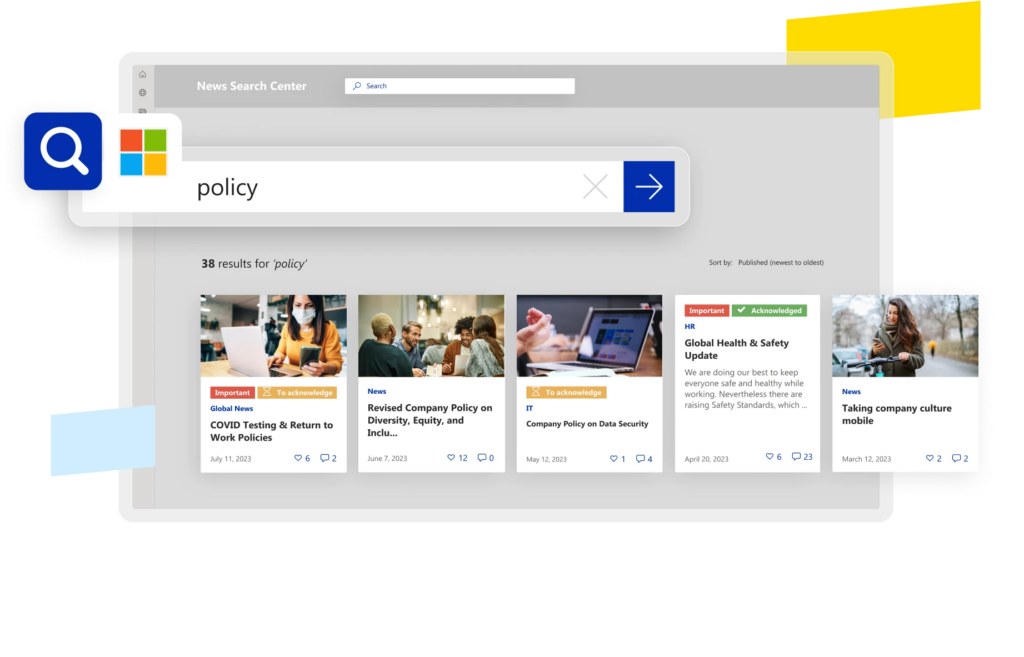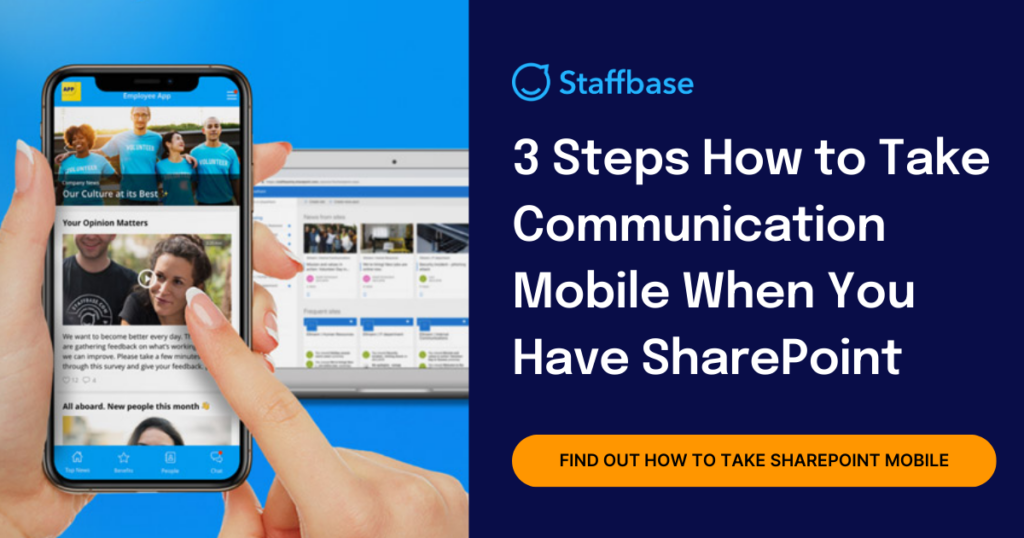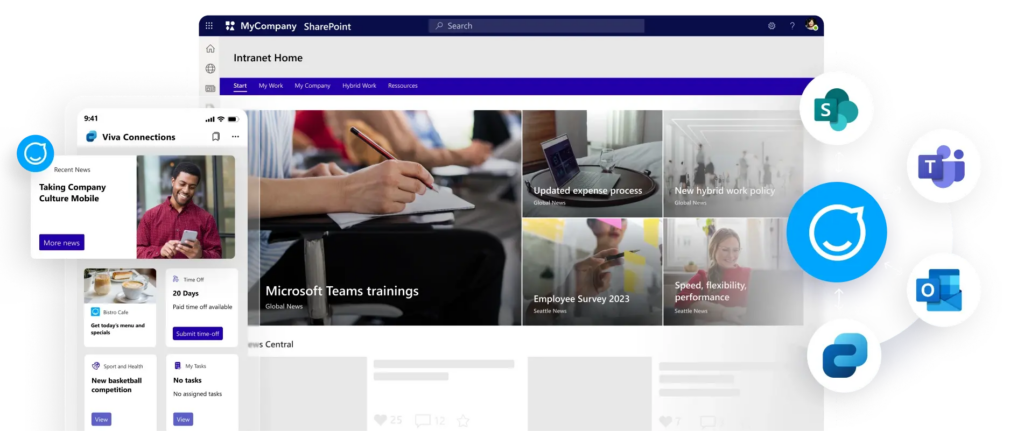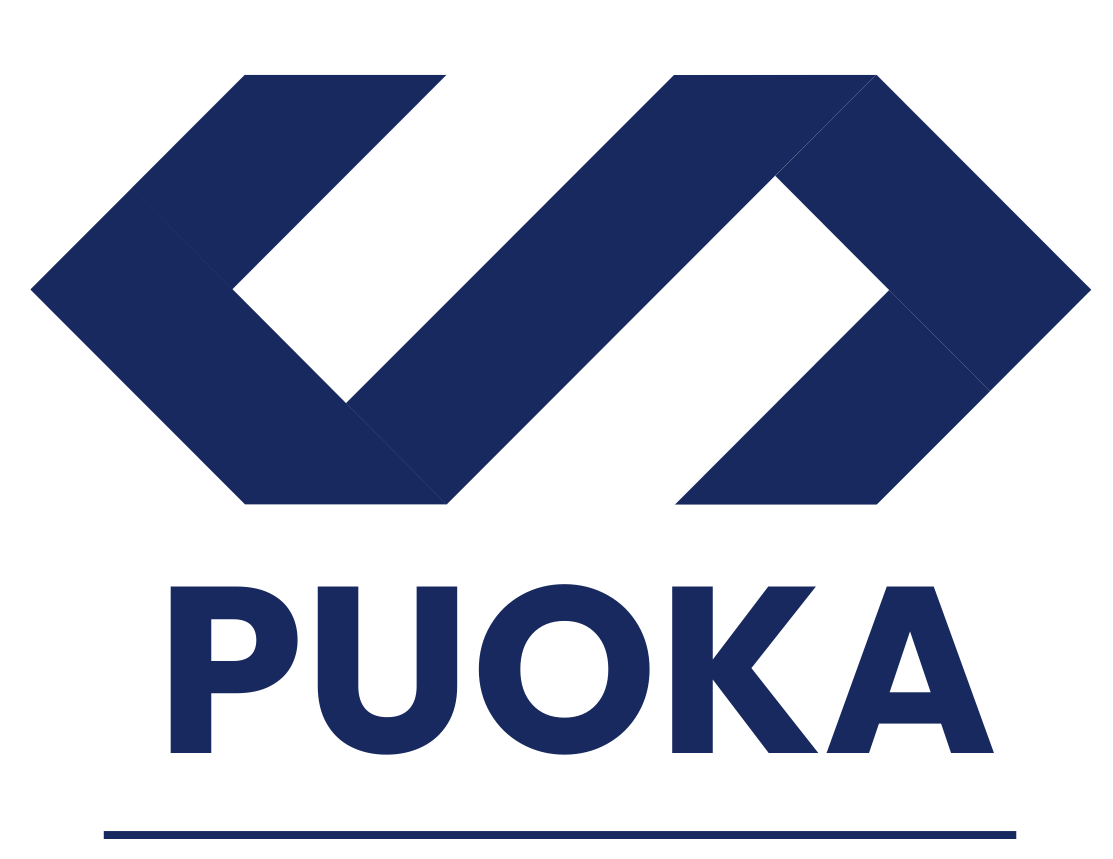SharePoint is a powerhouse that many organizations used to rely on for managing documents and resources. In addition to its robust document management capabilities, many companies also attempt to use SharePoint as a communications tool, leveraging it as an intranet platform to connect teams, share updates, and facilitate internal communications.
However, if your goal is to inspire and engage your entire workforce, SharePoint might not be the best fit for smooth employee communications.
While SharePoint excels at document management, it falls short in areas where vibrant, engaging employee communication is key. Companies that succeed in fully engaging their workforce understand the importance of investing in additional tools designed specifically for communication, rather than forcing SharePoint into a role it wasn’t built for.
In this article, we’ll explore why SharePoint is still an essential part of your toolkit and how you can supplement it with the right alternatives to create a comprehensive, effective intranet solution. After all, SharePoint is powerful—just not as a one-size-fits-all platform for every use case.
Why you should consider a SharePoint alternative?
SharePoint has long been a cornerstone in many companies’ digital workplace strategies, especially when it comes to resource management and file sharing.
It’s powerful, versatile, and deeply integrated into the Microsoft ecosystem, making it a natural choice for many organizations. Historically, its capability to handle different content formats has led companies to repurpose SharePoint as their “portal for everything,” including their main intranet for publishing company-wide news, information, and services.
However, when it comes to employee communications, SharePoint often falls short. The very strengths that make it an excellent tool for document management—its focus on complexity, flexibility, and productivity—also create significant barriers to effective communication. That’s because SharePoint’s inherent design isn’t geared towards being a simple, intuitive, and engaging communication hub, which presents several challenges for communicators.

Some key challenges of using SharePoint for communications include:
- High complexity, requiring strong IT support for setup and maintenance. This means that communicators often can’t manage it independently, as it’s just one of many use cases within the platform.
- Editors need extensive training and onboarding to effectively use it, which can be a barrier to efficient communication.
- The complexity of SharePoint’s interface can be disorienting for users, making it difficult for them to find the information they need.
- Limited targeting and personalization needed for effective communication, which SharePoint struggles to support due to its rigid structure.
- SharePoint’s complex and often opaque information architecture can lead to news and updates being widely scattered, making it hard for employees to stay informed.
- The analytics available in SharePoint are often fragmented and not easily accessible to communicators, limiting their ability to track engagement and effectiveness.
- SharePoint doesn’t natively support the key workflows that are essential for streamlined and effective communication.
Even if the communications team manages to work around SharePoint’s limitations, one central issue remains: It doesn’t reliably reach all employees. This is particularly acute in today’s workplace due to the rise of remote and hybrid work models, which have created a more geographically dispersed workforce.
As a result, the need for robust communication and culture-building tools has become more critical than ever, ensuring that employees stay connected, engaged, and aligned with the company’s mission, regardless of their location. These groups—ranging from top-down teams to grassroots communities—can’t be effectively engaged through a one-size-fits-all approach.
Your workplace will evolve. While you can continue to rely on SharePoint for resource management and collaboration, you should consider alternatives for your own communication needs to ensure they’re reaching and engaging their entire workforce effectively.
What is Microsoft SharePoint?
SharePoint remains one of the most popular productivity tools for a good reason. With over 23 years on the market, its longevity and success are rooted in its strengths. SharePoint excels at document and resource management, making it an essential tool for file sharing within organizations.
It’s embedded in Microsoft 365-focused digital workplaces, serving as the backbone for modern applications like Teams, Stream, and Viva Connections. SharePoint’s extensive configurability and fine-grained rights and access management make it particularly well-suited for storing confidential and highly confidential data. Despite its gaps, its versatility keeps it going strong today.
What to look out for in Microsoft SharePoint alternatives
If you want to introduce a platform that will help bring your whole workforce together, there are multiple factors to consider—especially in the context of modern communication challenges. Ensuring the platform supports seamless communication across dispersed teams, fosters engagement, and builds a cohesive company culture is essential in today’s rapidly evolving work environment.
- Digital workplace fit
Your new solution should seamlessly align with your broader digital workplace strategy, ensuring a cohesive employee experience. If your organization relies on Microsoft, prioritize solutions with deep and robust Microsoft integrations. Additionally, ensure that the platform offers well-documented APIs to support the setup of custom use cases.
- Available communications channels
The limited mobile experience of SharePoint is a significant barrier to adoption, though not the only one. While a mobile company app is essential in today’s communications strategy, it’s important to have a broader set of channels and tools to reach a diverse workforce with varying preferences. Choose a vendor that allows you to start small and scale as needed, adding channels like email, digital signage, and SMS when the time is right.

- Communications workflows
To enhance both effectiveness and efficiency, ensure your platform supports the entire communications workflow as comprehensively as possible. This includes planning and collaborating on content across various channels.
- Personalization and targeting capabilities
One common challenge communications teams face is that users often feel overwhelmed by the sheer volume of content, with only a fraction being relevant to them. To address this, it’s crucial to tailor the experience for different audiences, ensuring that navigation, quick links, and content structures are customized to meet specific needs.
For example, a marketing employee in Bristol will have different information requirements and expectations compared to a delivery driver in Marseille. Your platform should make it easy to deliver relevant, targeted content to each distinct audience seamlessly.
- Information architecture
Your SharePoint alternative of choice should enable the integration of both global and local content seamlessly. It can also feature a global navigation structure that incorporates local elements, allowing for a cohesive yet customizable user experience.
- Multi-language support
For employees across different countries, ensure that your platform allows content to be accessed in their preferred language, whether it’s English, Portuguese, or another option. Pay attention to the nuances of multi-language features: What aspects of content can be translated, how is translation managed, and who is responsible for it?
Consider the support available to users and the options for editors. Additionally, check whether multilingual news items generate separate analytics or if performance is tracked as a single content piece. While these may seem like minor details, they can significantly impact your daily operations.
- User management and authentication
When evaluating alternatives to SharePoint, consider how user management will be handled, especially if your workforce’s data is spread across multiple systems or if some employees lack company email addresses. Ensure that user management is streamlined by supporting hybrid methods, such as using SCIM (System for Cross-Domain Identity Management) for certain groups and CSV imports for others.
Additionally, think about user authentication. This can be a major barrier to adoption if not handled effectively. Consider hybrid solutions, such as Single Sign-On (SSO) for employees with existing digital accounts and providing a username and password option for those without a digital identity.
- Security and compliance
Ensure the platform holds relevant certifications, including SOC 2 Type 2 and ISO 27001. These standards ensure robust protection of customer data throughout its lifecycle. ISO 27001, in particular, is a key international standard for information security management, and adherence to it reflects a commitment to maintaining high security standards.
- Support
Ensure the platform provides support in your preferred language. In case issues arise, it’s crucial to have timely assistance—check the response times specified in the Service Level Agreement (SLA).
Ideally, support should go beyond just configuring the technical infrastructure and actively partner with you throughout your communications journey. Look for a vendor that will help you maximize reach, boost adoption, and effectively engage your audience.
6 best SharePoint alternatives
1. Staffbase
Staffbase is a multi-channel communications platform crafted to connect, engage, and inspire all employees, while supporting strategic communications. It provides the tools needed to deliver targeted messaging, align teams with company goals, and foster a unified workforce, no matter where employees are located.
Pros
- Personalized front door intranet: Staffbase serves as a primary front door for all employees, accessible on any device, anywhere.
- Custom branded mobile app: A native, branded employee app available in public app stores helps build trust and drive adoption from day one, whether employees are desk-based or on the go.
- Minimal onboarding: Editors experience minimal onboarding, making it straightforward to get started and include part-time editors.
- Communications ownership: The platform can be easily managed by your communications team, offering a fast setup and simple maintenance.
- Scalable multi-channel options: Start small with Staffbase and expand as needed, adding channels like email, digital signage, Teams, and SMS when the time is right.
- Robust Microsoft 365 integrations: Staffbase integrates deeply with Microsoft 365, covering user management, authentication, and flexible two-way integrations. It also includes a Power Automate Connector.
- Support for strategic communications: Plan and coordinate communications more strategically, aligning communications campaigns with your company’s goals and measuring the impact on your business.

Comparison with SharePoint
Staffbase is not designed to replicate SharePoint by offering a broader or more comprehensive feature set, nor is it intended to serve as an equally extensive portal. Instead, Staffbase is a leading platform specifically for employee communications and engagement, with a focus on seamlessly integrating into your existing Microsoft 365 landscape.
Cons
While Staffbase excels in providing a unified front door for employees, delivering news, information, and services relevant to large groups, it’s not designed to replace SharePoint entirely. Instead, it complements SharePoint, seamlessly integrating with it to enhance communication and engagement.
Pricing
Staffbase offers three main pricing plans tailored for different business sizes and needs:
- SMB (Small and Medium-sized Businesses): Designed for companies with up to 1,000 employees, featuring a branded mobile app, push and email notifications, targeting and personalization, news and social feeds, and more.
- Business: Includes all SMB features plus Companion AI Editor, auto-translation, in-depth analytics, editorial calendar, customization options, and APIs.
- Enterprise: Adds campaigns, ghostwriting, automated journeys, local content management (Spaces), custom app distribution options, and everything in the Business plan.
For detailed comparisons and quotes, visit the pricing page.

2. Haiilo
Haiilo is a versatile employee communications platform designed to enhance internal engagement and streamline communication across organizations. By consolidating various communication channels, Haiilo simplifies the sharing of updates and information, ensuring employees are aligned and informed. Key features include a social intranet, interactive forums, real-time chat, and targeted content delivery, which empower organizations to communicate effectively and encourage collaboration.
Pros
- It’s highly rated for responsive support and proactive customer service.
- Allows thorough customization to meet specific organizational needs.
- Haiilo’s intuitive design makes it easy for employees to onboard and use the platform effectively.
Cons
Users have noted shortcomings such as a lack of multi-language features, limited customization options (e.g. navigation), and weak integrations with M365.
Pricing
Haiilo employs a tailored pricing strategy based on organizational needs, with features distributed across three main packages that come at gated costs:
- Core: Includes essential communication tools.
- Business: Adds advanced features like content management and enterprise search.
- Enterprise: Delivers comprehensive engagement insights with analytics.
Haiilo offers add-ons such as employee advocacy and advanced analytics.
3. LumApps
LumApps is a cloud-based employee intranet and digital workplace solution designed to enhance internal communication, collaboration, and engagement within organizations. LumApps allows companies to broadcast important updates, news, and announcements to all employees. The platform’s personalized news feeds mean that employees receive relevant information based on their role, location, and interests. It offers features such as personalized news feeds, social communities, knowledge management, and user-friendly content creation.
Pros
- LumApps integrates seamlessly with popular productivity tools like Google Workspace and Microsoft 365, allowing employees to access documents, calendars, and emails directly from the intranet.
- The platform is highly customizable, enabling organizations to tailor the intranet to their specific needs.
- Whether you run a small business or a large enterprise, LumApps can scale to meet the needs of organizations of any size.
Cons
The platform lacks workflows to support manual translation, which can be a challenge for organizations with multilingual teams. It also does not offer specific services tailored to frontline workers, limiting its utility for industries with a large deskless workforce. Additionally, weak analytics have been highlighted in voice of the customer feedback, indicating that the platform may not provide the depth of insights some companies need for measuring communication effectiveness and employee engagement.
Pricing
With this Microsoft SharePoint alternative, you can choose from three core plans:
- Business: For organizations looking for a leading intranet solution to streamline internal communications and manage team-based content effectively.
- Professional: For organizations that need to improve peer-to-peer communication and collaboration across teams.
- Enterprise: For large enterprises with complex needs.
Pricing isn’t publicly displayed but you can expect to pay extra for add-ons.
4. Oak Engage
Oak Engage acts as an employee intranet platform and can serve as a go-to hub for employees to access important company information, collaborate with colleagues, and stay informed about company news and updates. Oak Engage is known for its user-friendly interface and robust feature set. This makes it a good pick for organizations looking to improve internal communications and foster a more connected workforce.
Pros
- The platform provides extensive collaboration features, including project management, file sharing, and real-time communication tools like chat and video conferencing. However, these use cases may create overlaps with popular Microsoft tools such as Teams and SharePoint, potentially leading to redundancy or confusion in organizations already invested in those systems.
- Oak Engage stands out through various features designed to boost employee engagement, such as social feeds, recognition tools, and surveys.
- Thanks to lots of customization options, you can tailor the platform when it comes to branding, content structure, or feature configuration.
Cons
Although Oak Engage offers extensive customization options, the initial setup and implementation can be complex and time-consuming. Some users might also experience a steeper learning curve when first adopting Oak Engage, particularly when it comes to using the more advanced features.
Pricing
Oak Engage offers tiered pricing plans designed to cater to different organizational needs but note the pricing isn’t transparent:
- Silver: Core intranet tools and an employee app to meet your essential communication and collaboration needs.
- Gold: Enhanced engagement with AI-driven personalized content to maximize employee interaction and relevance.
- Platinum: Full flexibility tailored for large enterprises, offering advanced features and customization options to meet complex organizational needs.
5. MangoApps
MangoApps taps into the employee experience space, combining features of an intranet, team collaboration tools, and social networking. The platform is built to help you enhance the employee experience by offering extra capabilities for project management, knowledge sharing, and employee recognition, making it a versatile solution for businesses of all sizes. It’s also worth noting that it integrates with existing systems you might already be using and is highly customizable to your unique needs and culture.
Pros
- With features like personalized news feeds and mobile access, employees can stay informed and connected, regardless of their location.
- Its robust social networking features allow employees to participate in forums, share ideas, and give recognition to peers through badges and shout-outs.
- MangoApps also supports knowledge sharing through a centralized repository for company resources, training materials, and best practices.
Cons
With so many tools in one place, the wide range of features and customization options can make the initial steps of implementing MangoApps complex and time-consuming.
Some users may find that MangoApps’ extensive feature set includes overlapping tools that they don’t need or already have in other software.
Pricing
Pricing can be complicated thanks to the six different plans you have to choose from. Each is suited for a different type of company and needs:
- Modern company intranet: A central hub designed to streamline company information and news, reducing inefficiencies and keeping employees informed.
- Employee app: A tool focused on employee engagement, offering features for recognition, well-being, and delivering impactful messages and timely updates to all employees.
- AI studio: A platform for creating AI-driven solutions that enhance HR support and self-service, improving overall efficiency and employee satisfaction.
- Intelligent work apps: AI-powered tools tailored to your company’s data and governance needs, aimed at unlocking the full potential of AI within your organization.
- Workplace by MangoApps: An enterprise social networking platform designed as a leading alternative to Workplace by Facebook, enabling robust employee interaction and collaboration.
- Customer community and service hub: A B2B community suite that creates a centralized platform for customers to engage deeply, enhancing customer service and community interaction.
Also note that while the pricing page promises no hidden fees, the actual costs for the plans aren’t publicly displayed so you’ll have to make a formal inquiry to get a quote.
6. Akumina
This employee experience and intranet solution was built on Microsoft 365 so it provides a highly customizable and scalable digital workplace that integrates seamlessly with Microsoft tools. The main focus of this platform remains delivering personalized experiences tailored to the needs of individual employees. This said, it’s a solution best suited for organizations that want to improve their internal communication through social networking and an extra helping hand from artificial intelligence.
Pros
- Although complex, Akumina’s team provides custom training for the platform so you won’t say it’s cumbersome to set it up and use it.
- There are lots of options to create personalized content and experiences based on individual employee profiles.
Cons
Compared to the other tools in this list, Akumina doesn’t publicly share as much information. For instance, if you want to know whether you can connect the platform to third-party tools you’re already using, you’ll have to ask for an official demo first.
Pricing
Akumina’s pricing plans aren’t publicly displayed. There’s only a page where you can ask for a quote after submitting your organization’s details.
Conclusion
SharePoint excels at document and resource management, making it an invaluable tool for these purposes. However, it’s unrealistic to expect it to perform equally well in a completely different role, such as employee communications.
While SharePoint remains a critical component of your digital workplace, it’s important to recognize its limitations in this area. Instead of trying to repurpose SharePoint as a communications channel, consider choosing specialized tools designed specifically for employee engagement. Use SharePoint’s strengths, ensuring it integrates seamlessly with your existing infrastructure, especially M365. When selecting an internal communications platform, prioritize solutions that foster a well-connected digital workplace with clearly defined, differentiated use cases.







